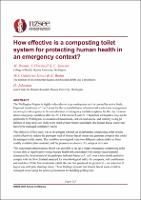How effective is a composting toilet system for protecting human health in an emergency context?

Download
Date
2021-04-14Authors
Brenin, Matthew
Gutierrez Gines, Maria J
Horswell, Jacqui
Stewart, Carol
Bohm, Kristin
Johnston, David
Metadata
Show full item recordAbstract
The Wellington Region is highly vulnerable to large earthquakes as it is crossed by active faults. Expected timeframes of 1 to 2 years for the re-establishment of networked wastewater management services provide urgency to the consideration of emergency sanitation options for the city. Lessons about emergency sanitation after the 2011 Christchurch and 2016 Kaikōura earthquakes may not be applicable to Wellington, as isolation of households, lack of road access, and inability to dig pit latrines or long drops are likely to be much greater factors and imply that human faecal waste may have to be managed completely onsite.
The objective of this study was to investigate whether an experimental composting toilet system could effectively reduce the pathogen load of human faecal matter and generate compost that could be managed safely onsite. The variables investigated were two different carbon additives from readily available plant material, and the presence or absence of a compost activator.
This experiment demonstrated that it was possible to set up a simple emergency composting toilet system able to significantly reduce human health risk associated with human faecal material (measured by the presence of the pathogen indicator bacteria E. coli) over a two-month period to comply with the New Zealand standard for microbiological safety for composts, soil conditioners and mulches. Of the four treatments tested, the one that produced the greatest E. coli reduction (7 log10) was with pine shavings alone. These findings indicate that treated faecal waste could be managed onsite using the normal precautions for handling potting mix.
